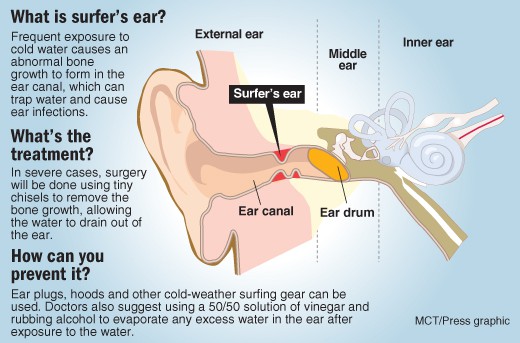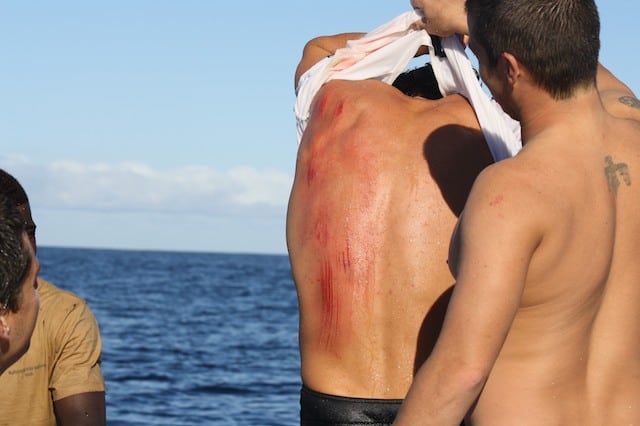Much of what we see about surfing in films and videos is the perfection of the surfer riding enormous waves, confidently standing motionless on the surfboard. While the goal for a lot of surfers is to catch big waves and experience the sublime feeling of motionless and timelessness, attempts to get there is fraught with injuries. Surfing is a sport just like football and baseball, but the injuries and the dangers that can happen to surfers are different from other sports.
What are common injuries you can get from surfing? The most common injuries are cuts and scrapes, sprains, broken bones, head trauma, and “surfer’s ear.” Lacerations like deep cuts and full body scrapes can be severe, and broken bones and sprains can take surfers out of the sport for months at a time. Unforgettably, some of these injuries can either result in partial or full body paralysis and even death.
How Do Surfers Get Injured?
By and large, surfing is a safe activity, made safer when you understand ocean conditions and how the ocean when you go out surfing. I always check out surfing conditions near where I live before heading out to the beach. Ocean conditions may be different in Torrey Pines than they are in Huntington Beach, only about 80 miles away here in Southern California.
You can check ocean conditions online through the National Weather Service or local surfing forecasters. I check with lifeguards from time to time. They’re a great source of knowledge and information and give great advice about the beach and which activities are safe to do in the water on a given day.
Areas where surfers go that have coral reefs, rocky seabed, and piers are less safe to surf than areas where beach breaks occur where there are soft sea beds. Even the most experienced surfers can get lacerations near coral reefs and even where the sea beds are soft. This is because once a wave takes hold of us, we are unable to fight back when it carries us at high speeds into rocks, reefs, and onto the seafloor.
Head Trauma
Injury to the head or the neck can happen when a wave tosses surfers down to the ocean floor. Depending on the force of the wave break, a surfer can hit the sea bed hard and twist their neck or bang their head. This can lead to loss of consciousness and drowning in the worst-case scenario.
Pro surfers riding the big waves have wiped out, hit the ocean floor, and suffered concussions. But if one is not careful, head trauma can occur even in relatively mild surfing conditions.
Hitting rocks on the sea bed can cause massive concussions, as pro surfer Shawn Dollar experienced. His recovery took months and took him out of the game for almost two years.
I surf off the California coast and one of the main things I avoid is crowds of surfers, even when I see wave after perfect wave rolling in. Too many surfers don’t wear leashes, people stay too close together and when they wipe out, their boards go flying in every direction. If they use longboards, those babies can cause some real damage to themselves or other surfers.
I try to surf when the waves first start breaking before the beach gets clogged up. No one wants to hurt anybody, but when people surf, they don’t know the power over their bodies that waves have, and unintentionally they injure others nearby.
My advice is, always wear a surfboard leash. Wait for your turn to ride. The guy or gal in the middle of the wave goes first. Use surfer etiquette and give everyone the space they need to stay safe.
Swimmer’s Ear
I love being in the water. When I was a kid, we had a below the ground pool. I took to that pool when I was really little and never looked back.
Surfing seemed to be a natural extension to swimming, and my favorite time is when I’m out challenging waves, trying to overcome and ride them as long as possible.

I have developed a swimmer’s ears a few times, and it’s no picnic. Swimmer’s ear, r otitis extrema, is an infection of the outer part of the ear, from the ear canal near the eardrum, that goes to the outside of the head. You get a swimmer’s ear when water is left inside the ear after hours of surfing or swimming. Bacteria and fungus grow in the moist environment from the water inside.
If you feel pain inside and around the ear, chances are you got a swimmer’s ear. You may need to see your doctor, who will give you ear drops to kill the infection and to keep the ear dry.
You can prevent swimmer’s ear by wearing earplugs and keeping sharp objects out of the ears. The best thing to do when you get out of the water is to make sure all the water has drained out of your ear. Tilt your head towards the ground to make sure all the water has gone out of your ears. Dry your ears thoroughly as soon as you can when you get out of the water.
Dislocations and Fractures
When the surf produces powerful waves and currents, you can paddle with too much force and cause shoulder dislocations. There is a class of injuries known as “board trauma,” where the body makes hard contact with the surfboard and results in facial fractures, bruises to the vocal cords, and even skull fractures. Often these are caused by surfboard leashes making contact with the body when you begin to ride the wave and are tossed over. On the way back up, the board hits you in the head or on the throat, causing bruising to tissue and tendons inside the body.
If you use a leash, always know where you are when you wipe out. If you go under, you have a few seconds to orient yourself and decide how you will get back to the surface without banging into your surfboard. Even if you don’t use a leash you can still collide with the surfboard floating above you.
The best way to avoid injury is to push off the bottom of the ocean at an angle away from where you wiped out, so you’ll rise in a place free of debris or other surfers. Don’t hurry to get up to the surface. If you can. Look up above to see if you can see any objects above you. This all happens in a split second, but that’s all the time you’ll need. Remember, you’ve got about 10 seconds and that’s enough time to rise slowly above the water surface.
Lacerations
Some of the best surfing spots also happen to be where there are rocks and coral reefs, and the sea bottom also has rocks and sharp objects. I have been scraped and cut and even had stitches after I scraped along reefs. Sometimes these cuts were so severe that infections occurred.

- It’s important to clean out any cuts you have after surfing, even deep cuts. The water you’re surfing in won’t clean them out as much as you might think. When you get home, completely clean the cut, and apply antibiotic ointment to it to prevent infection. If you notice a deep cut that’s gotten infected, you’ll want to call your doctor to get antibiotics and antibiotic ointment.
- Sometimes lacerations are deep enough that they require immediate treatment. Get out of the water and apply a compress to the wound. Keep it above the level of your heart. In the worst cases, press down hard with the compress and call an ambulance.
Related Questions
What Sea Creatures Should Surfers Keep An Eye Out For?
The number one nemesis to surfers is not sharks. Shark bites are a rare occurrence. The real threat surfers face is being bitten by jellyfish. These sea creatures populate the ocean in schools of hundreds or thousands. Their bite stings and can hurt. If you are bitten, treat the sting with warm salt water to get the spines and tentacles out from under your skin.
Always check with your lifeguard or daily surfer reports for jellyfish activity near your beach before hitting the waves.
Stingrays also can come up from the sea bottom and sting surfers. Treat these by applying hot water.
Is There A Way To Prevent Injuries?
Absolutely. Before surfing, do some stretching exercises to get the blood flowing in your body. Make sure your whole body is “awake” before hitting the surf. Follow stretching by doing fifteen minutes of aerobic exercise. You can jog, swim, or ride a bike to get your heart pumping. Doing this will speed up your reaction time in the water should a threat appear while surfing. Remember that surfing is a physical sport, and the better condition you’re in, the easier and safer you’ll get through a day surfing in the water.
Is There Gear I Can Get To Make Surfing Safer?
Today people are more safety -conscious than ever before, and that’s a good thing. Makers of surfing equipment have stepped up to the demand for safety gear. Now you can wear a surfer helmet to prevent brain and neck injuries. You can also get surf earplugs, specially designed for surfers.
When you swim near reefs, you can wear surfer boots designed to prevent scraping and cutting deep into the skin.

